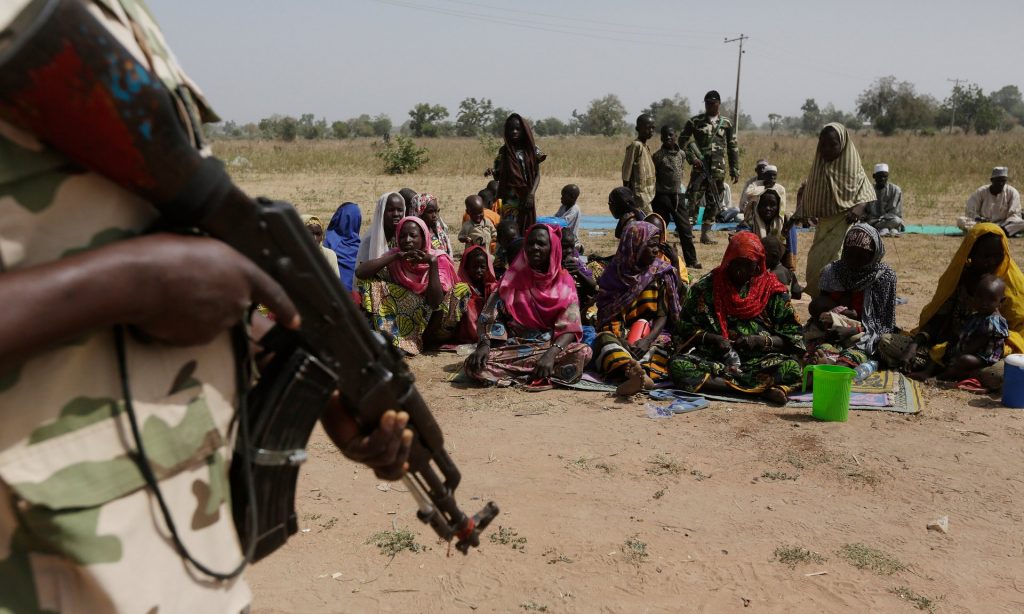
In recent years northern Nigeria, Chad and Niger have suffered droughts that have fuelled political violence.
Photograph: Sunday Alamba/AP
Climate-related disasters increase the risk of armed conflicts, according to research that shows a quarter of the violent struggles in ethnically divided countries were preceded by extreme weather.
The role of severe heatwaves, floods and storms in increasing the risk of wars has been controversial, particularly in relation to the long drought in Syria. But the new work reveals a strong link in places where the population is already fractured along ethnic lines.
Previous work has shown a correlation between climate disasters and fighting but the new analysis shows the disasters precede the conflict, suggesting a causal link. Experts have warned that an increase in natural disasters due to global warming is a “threat multiplier” for armed violence. The scientists behind the new research say it could be used to predict where future violence might flare, allowing preventative measures to be taken.
“Armed conflicts are among the biggest threats to people, killing some and forcing others to leave their home and maybe flee to faraway countries,” said Prof John Schellnhuber, director of the Potsdam Institute for Climate Impact Research in Germany and one of the research team. The combination of climate disasters and ethnic tensions make an “explosive mixture,” he said.
“People have speculated about climate links with conflict: some people say yes, some say no. But we find a really robust link,” Schellnhuber said.
“Economic and social disruption caused by climate disasters are in general not significantly linked to the outbreak of armed conflict, except in one class of countries or regions: where you have pre-fracturing by ethnic difference. The analysis also shows clearly the shock precedes the conflict era and so this is the first step to unravel the causal tangle involved in this environment-conflict relationship.”
The research, published in the Proceedings of the National Academy of Sciences, found that 23% of the armed conflicts in ethnically divided places were linked to climate disasters, compared to just 9% of all armed conflicts. Schellnhuber speculated that ethnic divisions might mean that the impact of a climate disaster would disproportionately impact one group more than another, due to their location or poverty level. “People immediately start scapegoating then,” he said.
The research team concluded: “This has important implications for future security policies as several of the world’s most conflict-prone regions, including north and central Africa as well as central Asia, are both exceptionally vulnerable to [manmade] climate change and characterised by deep ethnic divides.
“Recent analyses of the societal consequences of droughts in Syria and Somalia indicate that such climatological events may have already contributed to armed conflict outbreaks or sustained the conflicts in both countries.”
Schellnhuber said the climate-conflict link will be even more important in the future: “In 50 years from now, under a business-as-usual scenario, 80-90% of disasters will be driven by climate change. Then the whole thing really explodes.”
He said cross-referencing predictions of where extreme weather is likely to increase with places that are ethnically divided could provide a way to see trouble ahead. “You could construct a conflict ‘radar’ system to anticipate hotspots where the probability of armed conflict is high. Then you could try to diffuse certain things, or say, given the current migration debate, see where the potential sources of emigration are.”
Prof Solomon Hsiang, at the University of California Berkeley and not part of the new research, showed in 2011 that changes to the climate were linked to 20% of civil wars since 1950. He said: “The linkage between large-scale climatic changes and violence is a remarkable finding of the last several years and has major implications for societies around the world, both today and in the future.”
“Recent studies have demonstrated that these patterns hold around the world, throughout human history, and at all scales of social organisation: from violence within families all the way up to full scale civil war,” Hsiang said.
“This new study corroborates these earlier results, demonstrating that they can be recovered using an alternative statistical approach. It is important that these types of findings are replicated and demonstrated to be robust by numerous research teams since the consequences for society are so critical.”
Previous work has focused on linking conflicts with meteorological data, such as temperature and rainfall. The new analysis, however, used the economic impact of climate disasters, which takes into account the vulnerability of the nation affected. “Both Syria and California have now experienced the biggest drought on record, but there is no civil war in California,” said Schellnhuber.
He said the new work showed another, very significant, benefit of action to halt global warming: “Our study adds evidence of a very special co-benefit of climate stabilisation: peace.”
